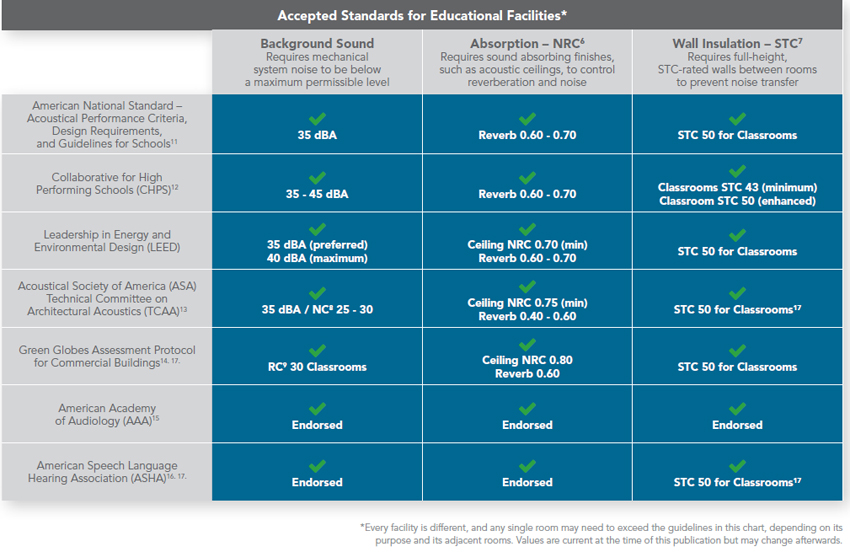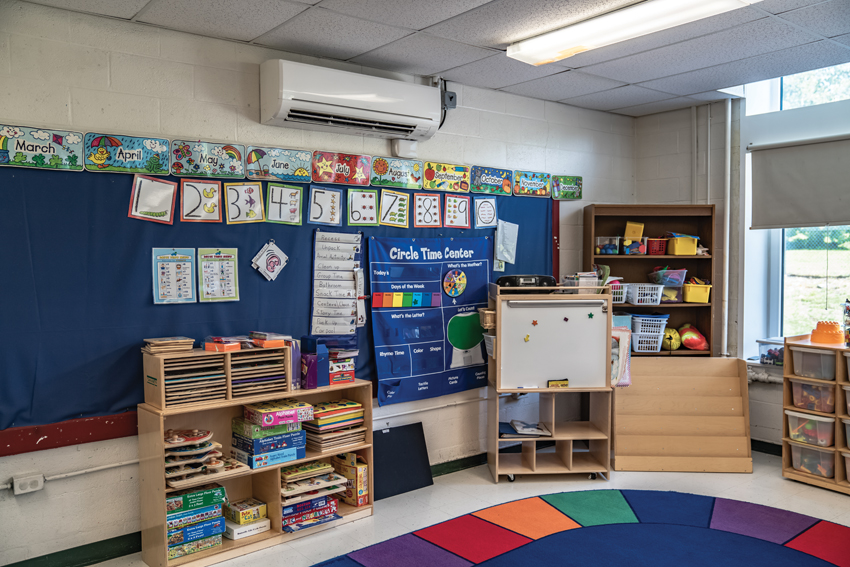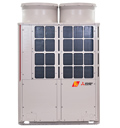Updated School Design in a Post-Pandemic World
Acoustical Considerations
The acoustical performance of learning spaces is covered by a variety of codes and standards. This makes sense since acoustics inside classrooms determine whether students can understand their teachers and learn from them. Poor acoustics have also been associated with human health issues in both the short- and long-term. To ensure optimized acoustics design, professionals need to use the right combination of highly sound-absorptive ceiling panels, robust walls, and sound- balanced floors, all working together. Acoustic ceilings are used primarily to absorb the sounds in the room. Walls that are built full height to the structural slab or roof above, and without holes or gaps, block outside noise from coming into the space. When rooms are above or below one another, the floor slab also plays a main role in sound isolation.
Many school buildings must now comply with the stringent acoustic requirements and performance levels in one or multiple standards, guidelines, or building rating systems. The table to the right compiles the absorption, isolation, and background sound level requirements from organizations such as the Collaborative for High Performance Schools (CHPS) and the Acoustical Society of America (ASA). Stone wool acoustic ceiling tiles can achieve highly absorptive Noise Reduction Coefficients (NRC) of 0.95 or higher, optimizing speech intelligibility and achieving the ultimate privacy in school buildings.

Image courtesy of Rockfon
This table indicates some of the common standards that address acoustics in schools with the ratings shown for compliance.
Acoustic Ceilings in Three Steps
A commonly available online tool helps architects optimize acoustic ceilings in school buildings by determining performance ratings for a space and selecting product options.
Step 1. Select the appropriate NRC rating for your ceiling panels based on published standards or experience. As the amount of sound absorption is increased inside a room, the reverberation time and noise level decrease. It also can reduce echoing. This improves speech intelligibility, allowing students to better understand their teachers.
Step 2. Select the appropriate STC rating for wall and floor/ceiling assemblies in order to keep out unwanted sound from adjacent spaces. Sound blocking starts with walls and floor slabs. If the adjacent room has a lot of people or equipment, and transmitted noise would interfere with sensitive activities being performed in the room being designed, then a high STC rating is needed. As the walls and slabs become more massive, the STC rating increases and the amount of noise getting through greatly decreases, making things much quieter.
Step 3. Ensure you have the proper background sound level. Quieter is not necessarily better. Some background sound is necessary to mask annoying or distracting noise and help achieve speech privacy. This background sound can be from music, nature, mechanical systems, or electronic sound masking (i.e., “white noise”).
Speech Privacy Potential (SPP) is another performance indicator of acoustic privacy between two adjacent rooms and may be better than either STC or background sound (dBA) alone. SPP factors both steps #2 and #3 of the process above, together. The STC rating, plus the background sound level, should total between 75 and 80—any less and privacy may not be achieved.
Interior Climate Control
In addition to attributes such as acoustics, a successful classroom environment that enhances learning includes the ability for pupils to feel comfortable during different seasons. This plays directly into the type of heating and cooling system that is used, and the ability for it to be responsive to different needs within a school.

Photos courtesy of Mitsubishi Electric Trane HVAC US
Variable Refrigerant Flow (VRF) indoor units blend easily into classrooms offering greater design flexibility, more precise comfort control, and ultra-quiet operation.

The compact, efficient nature of VRF systems allows for smoother operation, smaller footprints for equipment,
and quiet operation.
Variable Refrigerant Flow (VRF) Systems
Conventional HVAC systems have served the needs of most school buildings for many decades, although with some variability in comfort and energy efficiency. Achieving the high levels of comfort, sustainability, and performance needed for current school design often requires going beyond the conventional. Considerable success in this area has been found in the use of Variable Refrigerant Flow (VRF) systems which operate in a zoned manner. Zones are defined as single or multiple room spaces that are conditioned to a set temperature and are operated independently from other rooms within the same structure.
VRF systems move conditioned refrigerant directly to the zone to be heated or cooled, allowing the temperature of that area to be more precisely controlled. To save energy, they can limit conditioning to selected zones that are in use. Inverter technology enables VRF systems to modulate capacity to match each zone’s conditioning needs and maintain set points using minimal energy. If equipped with a branch circuit controller or heat-recovery module, VRF systems can simultaneously heat some zones while cooling others. With these features, VRF systems provide educational buildings with efficient, personalized comfort. Since their size and output can be selected for specific locations, they can meet the needs of a wide variety of spaces within schools – classrooms, cafeterias, auditoriums, gymnasiums, offices, and other spaces, each with varied occupancies and unique conditioning needs. Furthermore, the quiet operation of VRF systems makes them ideal for environments like libraries and classrooms, where students need to focus on their studies.
Enhanced Ventilation
An important strategy for helping to create healthy learning environments is to provide proper ventilation to bring in fresh air while exhausting contaminants. In that regard, VRFs can very easily be used with dedicated outdoor air systems (DOAS) and energy recovery ventilation systems (ERVs) to provide the needed fresh air to the school in an energy-efficient manner. From a health and wellness standpoint, these systems help rid school buildings of toxins, odors, bacteria, and other potentially harmful contaminants. ERVs also improve HVAC system efficiency by preheating or cooling incoming outside air with energy recovered from the exhaust air. All of that adds up to a healthier, more sustainable indoor environment for students and staff. For architects, VRF systems with ERVs mean flexibility in design, quiet operation, and the ability to modify the systems as needs change during the design or life cycle of the building.
Attributes of VRF Systems
Schools realize numerous benefits by using VRF zoning systems combined with ERV-based ventilation systems. The improved thermal comfort and indoor air quality can help enhance learning environments, allowing students to learn more easily, while teachers and staff are kept comfortable, too. Such systems have been shown to help with operational costs and sustainability as well. VRF systems are all-electric and provide heat without burning fossil fuels. Schools motivated to reduce their carbon footprint and improve air quality in their communities choose VRF systems to support those objectives while improving comfort. For renovation projects, the quick installation time for VRF systems means schools can minimize disruption to the academic year when upgrading to this advanced heating and cooling solution.
This technology is ideal for the wide variety of uses, schedules, and activities that can occur in a single school building since everything can be zoned to suit this variability. Inverter-driven VRF systems use only the precise amount of energy needed to keep each interior zone at the desired temperature. This allows for customized operation while also enhancing energy efficiency and the related cost savings – energy is only used where it is needed and in the amount that is needed. Different unit styles and sizes of VRF systems are available to meet diverse comfort and aesthetic needs. Due to their compact and efficient nature, VRF systems also offer streamlined operation and maintenance, simplifying the work of facility staff.
Notice

www.asi-accuratepartitions.com/privacy/

www.bradleycorp.com

www.mitsubishicomfort.com/commercial

www.nanawall.com/generation4

www.rockfon.com









